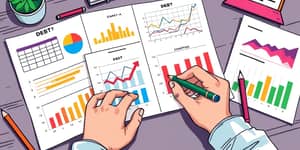
As interest rates climb, the importance of vigilant debt management becomes paramount. Variable rate debts—loans and bonds tied to market benchmarks—can transform from an affordable financing tool into a financial burden almost overnight. By understanding how these debts adjust, the risks they pose, and the strategies to manage them, borrowers and investors can not only weather rising rate cycles but also seize opportunities for stronger financial resilience.
Variable rate debt encompasses a range of financial products where the interest payment fluctuates with an underlying market index. These may include adjustable-rate mortgages, lines of credit, certain commercial real estate loans, and municipal bonds. Each is defined by an interest formula comprised of a chosen benchmark—such as LIBOR, SOFR, or SIFMA—plus a lender’s margin.
Loan agreements must disclose all details in an Adjustable Interest Rate (AIR) Table, specifying the initial rate, any rate floors or ceilings, the first reset date, frequency of changes, and adjustment caps. This transparency is crucial for borrowers evaluating their exposure as market rates shift.
When market indices move, variable rate debts reset according to the agreed schedule. A typical mortgage might adjust every six months, while a line of credit could reset monthly. These adjustments reflect the current index plus the predetermined margin, and any periodic or lifetime rate caps.
Understanding the initial, minimum, and maximum rates allows borrowers to forecast potential payment swings. Without this clarity, unexpected spikes can trigger cash flow crises, especially in businesses or projects with fixed revenue streams.
In an expanding rate environment, higher borrowing costs quickly erode budgets. Revolving debts like credit cards can see interest expenses surge, slowing principal repayment and prolonging debt duration. Commercial borrowers financing real estate or infrastructure projects may face dramatic increases in interest expenses, impairing project viability and financial ratios.
Because variable rate resets often occur within one or two billing cycles, delays in monitoring can turn manageable obligations into burdens that stretch resources and strain liquidity.
Consider a developer issuing variable rate bonds at 2.00% plus a 0.25% letter-of-credit fee, intending to refinance into fixed-rate debt after three years. If long-term rates rise by 45 basis points during that period, the total cost of the variable-to-fixed strategy matches choosing a fixed rate from the outset. Such scenarios highlight the importance of calculating a breakeven rate increase before deciding to float.
Economists estimate that a 56-point rise in federal debt-to-GDP can lift long-term interest rates by 170 basis points. Historically, each 100 basis point increase in debt-to-GDP correlates with a 4.6 basis point rise in borrowing costs, underscoring the macro pressures that coincide with rate cycles.
Variable rate debt carries multiple dimensions of risk:
Under the Truth in Lending Act (TILA), lenders must provide clear, timely disclosures for all variable rate products. These requirements include:
Compliance ensures borrowers have all the information needed to assess risk before signing loan documents.
Effective monitoring transforms uncertainty into actionable insight. Begin with payment forecasting and stress testing under various rate paths to gauge potential liabilities. Integrate modern treasury systems to build a real-time dashboard of your debt profile:
Armed with data-driven forecasts, you can decide when to hedge, refinance, or maintain a floating position in anticipation of favorable conditions.
In an era of rising rates, vigilance is your greatest ally. By mastering the intricacies of variable rate debt, leveraging advanced monitoring tools, and maintaining proactive risk management, you can transform a volatile environment into a strategic advantage. Financial resilience is not built by chance—it is achieved through informed decisions, rigorous stress testing, and unwavering attention to market signals. Embrace these practices, and you will not only survive rate cycles but emerge stronger and more adaptable in the face of economic change.
References













